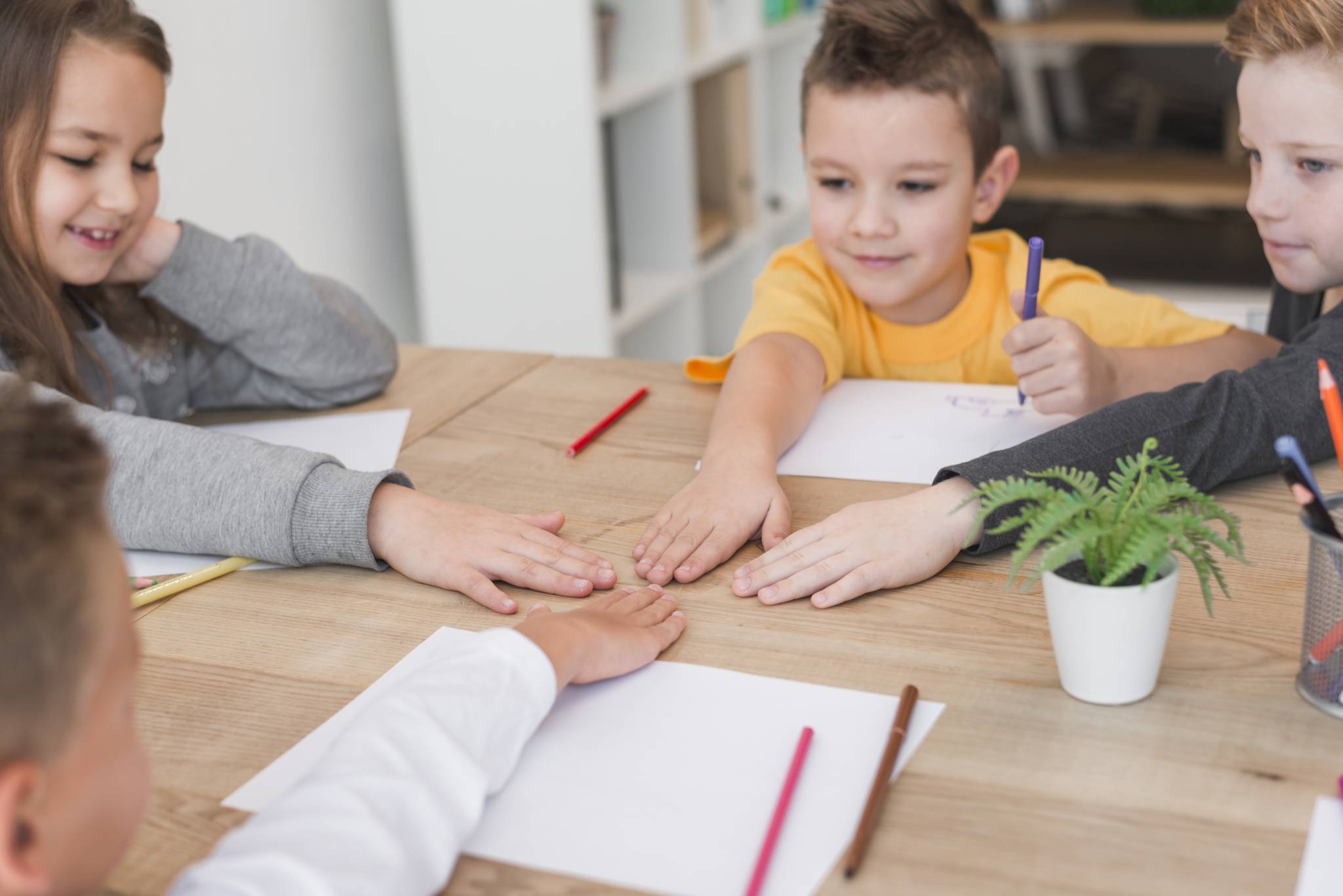9 Strategies For Teaching Social Skills To Autistic Children
What’s inside this article: Nine evidence-based strategies that can help children with autism develop or improve social skills. Includes teaching strategies, play strategies, and educational programs developed to aid social development.
If you have an autistic child who is verbal but needs help developing social skills and conversation skills, you’ve come to the right place. Let’s get started with a definition:
Pragmatics: The use and interpretation of language in social situations.
Nearly all autistic individuals struggle to understand pragmatics. Even someone with an above average vocabulary can struggle significantly with social interactions and conversational skills.
These are skills that seem to come naturally to most people but they need to be directly and specifically taught to children with autism.
This post is part of a 7 part series on techniques for improving communication skills. Each part of the series contains this table of contents so you can easily navigate to the other parts of the series.
Table of Contents:
- Learning to Listen & Oral Language Comprehension
- Developing Oral Language Expression
- Developing Social Language and Conversation Skills
- Milestones of Play & Targeting Skills Through Play
- Augmentative and Alternative Communication Tools
- Childhood Development: Language and Communication Milestones
- The Functions of Echolalia
Promoting Social Interaction and Skill Development
The development of social skills is an essential area of learning for kids with ASD. It should also be a crucial component of any intervention plan for changing problem behaviors.
Remember, this is because behaviors are usually communicative attempts used when kids lack the appropriate and adaptive skills to communicate in a better way.
So in order to help, you need to first assess their social competencies and get an idea of what they know, and what social skills need to be taught.
In order to develop these social skills, kids need the opportunity to practice by participating and interacting in a variety of natural environments where appropriate models, natural cues and stimuli, and functional reinforcers are available.
In other words, they need the chance to try out these skills in a variety of real-life situations.
Many people with ASD have difficulty understanding subtle social messages and have problems interpreting the non-verbal communication of others, such as facial expressions, gestures, or body position.
Usually, children with autism need to be explicitly taught these skills. This can be challenging, because although there are common “rules” to
List of Social Skills That Need to Be Taught

The aspects of social language and conversation need to broken down into smaller pieces and then each piece taught individually.
Children also need opportunities to practice these skills in various environments – such as at home with parents, at school with adults, at school with peers, at the playground with peers, etc.
There are numerous social skills, some more complex than others. I’ve listed a few below. But, if you’re not sure where to start, these six social skills are some of the most important.
Social Skills:
- Starting a conversation
- Staying on topic
- Politely interrupting a conversation
- Exiting a conversation
- Taking turns at appropriate times during conversation
- Using and interpreting body language
- Matching your voice to the person or situation
- Respecting personal space
- Understanding and using figurative language. For example, idioms, hyperboles, metaphors, etc.
- Expressing feelings
- Asking and answering questions
- Using appropriate greetings
- Following Instructions
More: Check out these 38 social-emotional skills for more ideas and tips for targeting specific skills.
Social Skills Digital Mega Bundle
98 pages of social narratives & visual supports for teaching social skills.
How to Teach Social Skills
Despite the unpredictability that
Parents and teachers can use various strategies to teach new social skills to children, such as:
- Teach and practice social skills in one-on-one situations first, then in small groups, and once comfortable, in larger groups.
- Modeling and imitation appropriate techniques
- Prompting and creating environmental cues
- Teaching with visual tools, such as social stories or comic strip conversations
- Providing a list of concrete “social rules” to follow.
This can be hard because social situations are unpredictable but there are some things that can apply universally, such as using manners when making a request. - Providing feedback on performance (For example, “I noticed when that person said hello to you, you didn’t say anything back. You should try saying “hello” when someone says it to you, and if you know their name you can say their name, too)
- Using social-emotional learning programs (for example, Superflex or zones of regulation)
- Roleplaying activities where you pretend to be someone and your child practices interacting appropriately.
- Play-based activities using social interaction (for example, playing grocery store where you’re the cashier and your child’s a customer). This play can be mostly adult-led, depending on your child’s play skills.
Strategies for Social-Emotional Skill Development
Social skills are an integrated aspect of all life skills – communication, self-help and advocacy, academic development, etc. that many strategies discussed in the behavior management series have aspects of social skills embedded into them and it’s not possible to completely separate social skill development from other areas of development.
However, the following strategies help to explicitly teach social situations and encourage the development of various social skills.
Direct Instruction
Social skills are best learned in the context of natural routines, where opportunities are available to make choices, solve problems, and use functional communication and social skills.
However, natural activities of the day do not always provide opportunities to teach those lessons that most of us learn during childhood without instruction.
Direct instruction is a good way to help children develop social play, peer-group participation, social communication, school interactions, and self-management skills.
Direct skill instruction:
- Identifies social skills that have to be developed
- Determines the steps required to build those skills
- Provides practice in a variety of settings
Social Thinking
Social thinking is critical in developing good social skills. It is defined as the social knowledge that we intuitively possess and that we continue to develop as we go through life.
In other words, it is what helps us consider other people’s points of view and their social behavior. Social thinking is the base of all social skills development.
Michelle Garcia Winner has developed “the social thinking treatment approach” – The Superflex Program. Many special educators, guidance
This is most beneficial for kids age 8 and up with high functioning autism. This approach delves deeper than teaching social response patterns (which is common in ABA therapy). It helps children actually develop a deeper understanding of social interactions.
The Superflex Program teaches kids:

Note: I am currently using the Superflex program at home with my own child.
We haven’t been doing it long, but the games and books are super engaging. My son asks me to read and play with him. So far, we have noticed an improvement in his awareness of his own actions and others.
Direct Instruction Strategies for Various Conversation Skills:
Understanding and using non-verbal communication:
Gestures, facial expressions, body language, tone of voice, and other non–verbal communications of meaning and feeling can be taught using visuals, role-playing, picture rehearsal, and discussion.
Waiting
Visual cues such as objects, pictures, and written words can provide concrete information to make the concept of waiting less abstract and more specific to the situation. Visual timers are also a simple and effective way to help children understand the concept of waiting.
Taking turns:
Turn-taking can be taught through the use of social stories and by using a picture or pictograph to cue your child.
You may also need to teach turn taking when it comes to activities, not just speaking. You can practice this by playing games and activities that involve 2 or more players and require taking turns.
For example, the card game “Go Fish” requires you to take turns playing and speaking but it’s also is predictable – You ask for a card, if the other player has the card, they’ll give it to the other, if they don’t they will say “Go Fish”.
Making transitions:
Using social stories and providing change warnings with visual cues (Like symbols understood by your child, or a gesture), can help them transition from one activity to another.
Transitions can be particularly difficult if your child hasn’t finished the activity; they may need to be prepared for the possibility of having to finish later.
Read 8 ways to make transitions easier for more tips with helping your child with various types of transitions.
Changing the topic in conversation
Some kids might stay on one topic and appear unable or unwilling to talk about anything else. Professionals often refer to this behavior as “preservation”.
You can use strategies such as v
Completing tasks
Teach your child how to tell when a task is finished by using environmental cues, such as observing and following the behavior of other children in their class.
It may also help to use a timer, to teach methods for checking their own work, or to show a visual of what a task looks like when it’s all done. For example, taking a photo of their bedroom when it’s clean and using it as a visual when you ask your child to clean their room.
Initiating an interaction:
Social stories or cartooning are good ways to teach kids how to approach and initiate social interactions with another person.
Some common initiation for school-age kids include: asking for something, joining a game, saying hello, and politely leaving a situation
Being quiet
Most of us can tell from environmental cues alone, when it’s appropriate to be loud, and when you must be quiet. For kids with ASD, those cues may be missed, or it can be extremely difficult for them to shift their mindset if going from a loud activity to a quiet one.
Use visual supports for being quiet and for teaching rules for specific situations.
Prompting
You can encourage social interactions by using prompting. This technique, which follows the most common ABA-based teaching, involves prompting your child to engage in a specific interaction (such as saying hello, please and thank you, saying goodbye, etc) and then when your child does, praising them and offering positive reinforcement.
If your child doesn’t, then you can repeat the prompt.
I advise using this strategy sparingly because excessive use a prompts disrupts what should be a smooth interaction. It can also be stressful for the child to have repeated unpleasant demands placed on them.
Children can become dependent on prompts as well, so it’s important to have a prompt fading strategy in place.
Structured Play
Structured integrated play groups can provide opportunities for younger kids with ASD to interact with their peers and is a natural environment for the incidental teaching of social skills.
Playgroups provide natural situations where children have the opportunity to practice using language to express wants, practice being near other children and imitate social interactions observed between their peers.
Playing has a significant role in childhood development across all domains. Most early learning is done through play-based activities.
It is through play that children learn to interact, relate to their peers, and establish their first friendships.


